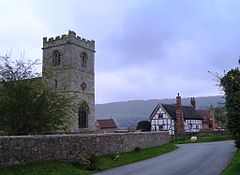Harley, Shropshire
| Harley | |
|---|---|
 Harley village with Wenlock Edge in the distance |
|
| Harley shown within Shropshire | |
| Population | 163 (2011) |
| OS grid reference | SJ595015 |
| Civil parish |
|
| Unitary authority | |
| Ceremonial county | |
| Region | |
| Country | England |
| Sovereign state | United Kingdom |
| Post town | SHREWSBURY |
| Postcode district | SY5 |
| Dialling code | 01952 |
| Police | West Mercia |
| Fire | Shropshire |
| Ambulance | West Midlands |
| EU Parliament | West Midlands |
| UK Parliament | |
Harley is a village and civil parish in the English county of Shropshire. The population of the civil parish at the 2011 census was 163.
The village lies at the foot of Wenlock Edge about 9.5 miles to the south-east of Shrewsbury. The A458 road Shrewsbury to Bridgnorth road goes around the village on a bypass. The village is about 105 metres (344 ft) above sea level on the southern slope of an extensive bed of sand and gravel, which creates an undulating landscape to the north-east of the parish. Harley Brook runs north-east across the centre of the village.
To the south east of the village is the market town of Much Wenlock. Nearby villages include Kenley, Cressage and Homer.
There is evidence of prehistoric human activity around Harley, as stone implements and a settlement have been found in the area, and the site of a Roman villa has also been found nearby. Harley was recorded in the Domesday Book in 1086 as a manor with enough wood for 100 swine, and before 1066 the parish consisted of 4 manors: Harley, Domas, Rowley and Blakeway.
St Mary’s parish church is first recorded in 1291, the medieval church consisting of a chancel, nave, north aisle and western tower. The small 13th-century tower was rebuilt in the early 16th century in Perpendicular style. This is the only part of the pre-Reformation church remaining, as it was mostly rebuilt in 1845-6 by a local architect Samuel Pountney Smith.
...
Wikipedia

